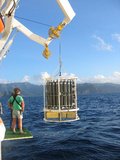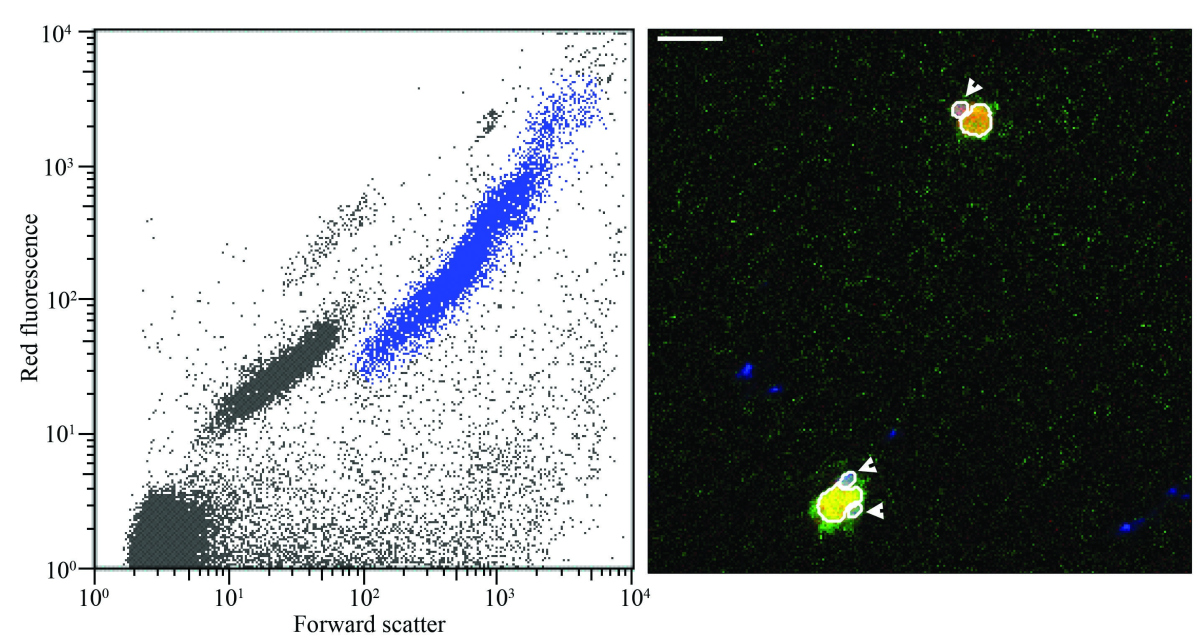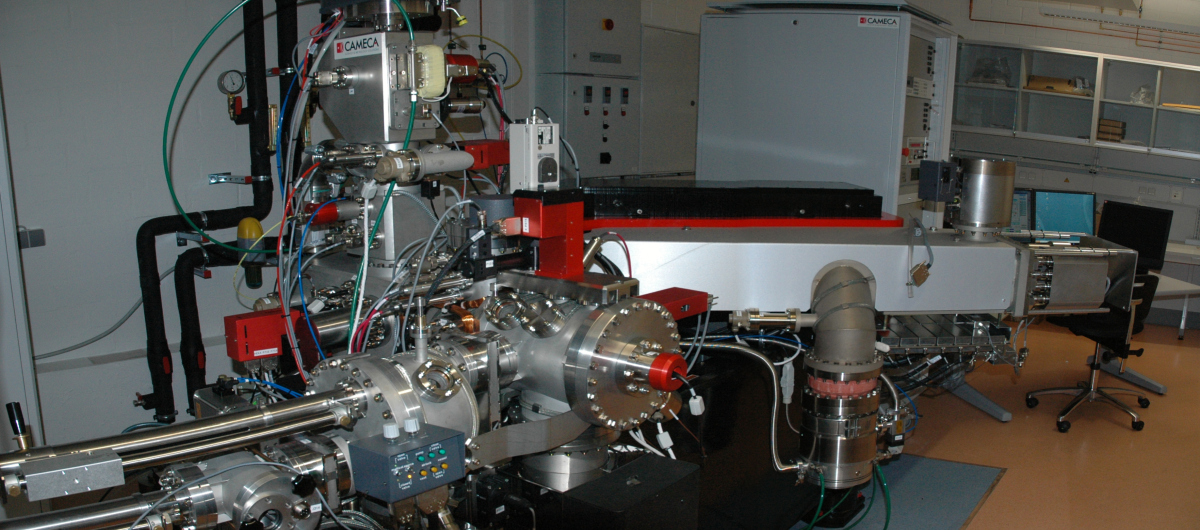Page path:
- Press Office
- Press releases 2012
- 20.09.2012 Unusual symbiosis discovered among m...
20.09.2012 Unusual symbiosis discovered among marine microorganisms
Unusual symbiosis discovered among marine microorganisms
Tiny single-celled algae and nitrogen-fixing bacteria exchange carbon and nitrogen in a mutually beneficial relationship that helps fertilize the oceans
An international team of scientists from France, Germany and the USA have discovered an unusual symbiosis between tiny single-celled algae and highly specialised bacteria, the first symbiotic relationship known between these types of organisms. Their partnership plays an important role in marine ecosystems, fertilizing the oceans by taking nitrogen from the atmosphere and "fixing" it into a form that other organisms can use.
Details of the symbiosis emerged from the investigation of a mysterious nitrogen-fixing microbe with a drastically reduced genome. First detected in 1998 by Jonathan Zehr, a professor of ocean sciences at the University of California, Santa Cruz, it now appears to be the most widespread nitrogen-fixing organism in the oceans. The microbe belongs to a group of photosynthetic bacteria known as cyanobacteria, but it lacks the genes needed to carry out photosynthesis and other essential metabolic pathways. Apparently, its association with a photosynthetic host cell makes those genes unnecessary.
"The cyanobacterium is a nitrogen-fixer, so it provides nitrogen to the host cell, and the host cell provides carbon to the cyanobacterium, which is lacking the metabolic machinery to get its own carbon," says Anne Thompson, co-first author of the paper and a postdoctoral researcher in Zehr's lab at UC Santa Cruz. Rachel Foster of the Max Planck Institute for Marine Microbiology is the other lead author and contributed equally to this work.
In order to unravel the mystery, the researchers used techniques such as cell sorting and gene sequencing. The host cell is a type of single-celled algae in a class known as "prymnesiophytes," which are found throughout the world's oceans. In seawater samples sorted by flow cytometry, which separates cells by size and colour, the host cells are sorted into the "photosynthetic picoeukaryote" population, meaning tiny single-celled algae in the 1 to 3 micron size range. The cyanobacteria are mostly seen in an indentation at one end of the host cell.
Tiny single-celled algae and nitrogen-fixing bacteria exchange carbon and nitrogen in a mutually beneficial relationship that helps fertilize the oceans
An international team of scientists from France, Germany and the USA have discovered an unusual symbiosis between tiny single-celled algae and highly specialised bacteria, the first symbiotic relationship known between these types of organisms. Their partnership plays an important role in marine ecosystems, fertilizing the oceans by taking nitrogen from the atmosphere and "fixing" it into a form that other organisms can use.
Details of the symbiosis emerged from the investigation of a mysterious nitrogen-fixing microbe with a drastically reduced genome. First detected in 1998 by Jonathan Zehr, a professor of ocean sciences at the University of California, Santa Cruz, it now appears to be the most widespread nitrogen-fixing organism in the oceans. The microbe belongs to a group of photosynthetic bacteria known as cyanobacteria, but it lacks the genes needed to carry out photosynthesis and other essential metabolic pathways. Apparently, its association with a photosynthetic host cell makes those genes unnecessary.
"The cyanobacterium is a nitrogen-fixer, so it provides nitrogen to the host cell, and the host cell provides carbon to the cyanobacterium, which is lacking the metabolic machinery to get its own carbon," says Anne Thompson, co-first author of the paper and a postdoctoral researcher in Zehr's lab at UC Santa Cruz. Rachel Foster of the Max Planck Institute for Marine Microbiology is the other lead author and contributed equally to this work.
In order to unravel the mystery, the researchers used techniques such as cell sorting and gene sequencing. The host cell is a type of single-celled algae in a class known as "prymnesiophytes," which are found throughout the world's oceans. In seawater samples sorted by flow cytometry, which separates cells by size and colour, the host cells are sorted into the "photosynthetic picoeukaryote" population, meaning tiny single-celled algae in the 1 to 3 micron size range. The cyanobacteria are mostly seen in an indentation at one end of the host cell.
Confocal microscope images of a UCYN-A symbioses. The blue stains the DNA and the green results from a highly specific probe to the UCYN-A cell. Images are of cells collected in the North Pacific Ocean at Station Aloha. Arrows designate the UCYN-A cell found attached to a larger cell. Scale bar is 1.0 μm. (images are courtesy of co-author Dr. Niculina Musat and MPI colleague, Dr. Cristina Moraru and were taken with a Zeiss LSM510 Cofocal Microscope).
UCYN-A cells were detected and sorted by flow cytometry (left panel) that detects cells by their size (forward scatter, X-axis) and pigments (red fluorescence, Y-axis). Nitrogen fixation and carbon fixation were measured by incubating seawater with stable isotopes, sorting the cells by flow cytometry, and then quantifying stable isotopes of individual cells using secondary ion mass spectrometry (nanoSIMS)(Right panel). The green in the image shows were nitrogen gas was fixed into organic matter by UCYN-A and transferred to the host picoplankton. Scale bar 3.0 μm (Image courtesy of co-first author Rachel A Foster, MPI Bremen, Germany).
The nanoscale secondary ion mass spectrometry instrument (nanoSIMS 50L) housed at the Max Planck Institute for Marine Microbiology in Bremen, Germany, where the single cell stable isotope measurements of nitrogen and carbon fixation in the UCYN-A symbioses were performed. (Image courtesy of Manfred Schlösser, MPI Bremen, Germany).
Left: Photograph of seawater sampling during the BIOSOPE (Biogeochemistry and Optics South Pacific Experiment) cruise to the Southeast Pacific. (Image courtesy of co-author Daniel Vaulot of the Station Biologique, Roscoff, France).Right: Map of the stations in the North and South Pacific where UCYN-A symbioses were found.
"Aside from the importance of nitrogen fixation in marine ecosystems, this is such an interesting symbiosis from an evolutionary perspective, because it can be seen as analogous to an early stage in the endosymbiosis that led to chloroplasts," explains Zehr.
Chloroplasts, which carry out photosynthesis in all plants, evolved from symbiotic cyanobacteria that eventually became incorporated into their host cells in a process known as endosymbiosis. The newly discovered nitrogen-fixing partnership is reminiscent of the interactions thought to have led to the evolution of chloroplasts.. "At this point, it's unclear exactly how the cyanobacteria are associated with the host cells. It looks like there may be a little groove in the host cell where the cyanobacteria fits," says Thompson. "The association is robust enough to go through the cell sorter and other preparations, but delicate enough that they separate if they're filtered or frozen and thawed."
In previous work Zehr's team had studied the cyanobacteria, which they called UCYN-A, in samples processed at sea and brought back to the lab for cell sorting and genetic analysis. Despite being unable to grow it in the lab, they were able to sequence the microbe's complete genome and discover that it was missing the genes for several key metabolic pathways, suggesting that it might live in association with another organism. Thompson said researchers were only able to see the symbiotic partners together when they sorted fresh seawater samples on board the ship.
The exchange of carbon and nitrogen between the two partners was demonstrated using powerful analytic techniques developed and carried out by collaborators from the Max Planck Institute for Marine Microbiology in Bremen, Germany. Co-first author Rachel Foster, scientist at the Institute, describes how they found out how the partnership between the two works. "We used labelled substrate and could track down the intercellular traffic. The strategy was to incubate the seawater samples with stable isotopes of carbon (13C) and nitrogen (15N), and then sort the 1-3.0 µm diameter cells by flow cytometry.”
A highly specific genetic probe developed by Niculina Musat, a Max Planck researcher, was used to identify the UCYN-A cells among the "photosynthetic picoeukaryotes" separated out by the cell sorting equipment. Marcel Kuypers, director at the Max Planck Institute, adds: "This probe is labelled with fluorine (F), an element with a mass of 19, which like the carbon and nitrogen isotopes can be detected by mass in the high resolution nanometer scale secondary ion mass spectrometer (nanoSIMS) instrument.” The nanoSIMS data proved the identity of the UCYN-A and their association with another cell by the 19F signal, and also quantified and imaged the carbon and nitrogen isotopes within individual cells.
"It's a great tool for microbiology, coupling phylogenetic identification with metabolic analysis," Thompson said. "We could see that the cyanobacteria were fixing the labelled nitrogen and transferring it to the host cells."
Genetic analysis of the host cell indicates its closest relative is the species Braarudosphaera bigelowii. In many species of prymnesiophytes, including B. bigelowii, the cells form external calcified plates, suggesting that the host cell in the symbiosis may have plates that are easily dislodged during processing of seawater samples. "That would be important, because cells with plates sink faster than other organisms, so the carbon they fix could end up being transported to the deep sea or the seafloor," explained Zehr..
Zehr noted that it is very difficult to estimate the contribution of this symbiosis to global carbon and nitrogen cycles. Other algae are more abundant and probably much more important in terms of oceanic carbon fixation than the algal host in this symbiosis. But the cyanobacterial partner probably makes a significant contribution to global nitrogen fixation in the oceans, he said.
"Planktonic symbioses are very understudied and difficult to study, as the associations are often fragile and difficult to keep intact," said Foster. "Here we used multiple tools and kept the relationship integrity, and also identified one of the first examples of a seemingly mutualistic partnership present in the plankton."
Zehr has named the cyanobacterium Candidatus Atelocyanobacterium thalassa. ("Candidatus" indicates a candidate or provisional name, since the rules of bacteriological nomenclature require that a microbe be grown in culture before the name becomes official.)
Chloroplasts, which carry out photosynthesis in all plants, evolved from symbiotic cyanobacteria that eventually became incorporated into their host cells in a process known as endosymbiosis. The newly discovered nitrogen-fixing partnership is reminiscent of the interactions thought to have led to the evolution of chloroplasts.. "At this point, it's unclear exactly how the cyanobacteria are associated with the host cells. It looks like there may be a little groove in the host cell where the cyanobacteria fits," says Thompson. "The association is robust enough to go through the cell sorter and other preparations, but delicate enough that they separate if they're filtered or frozen and thawed."
In previous work Zehr's team had studied the cyanobacteria, which they called UCYN-A, in samples processed at sea and brought back to the lab for cell sorting and genetic analysis. Despite being unable to grow it in the lab, they were able to sequence the microbe's complete genome and discover that it was missing the genes for several key metabolic pathways, suggesting that it might live in association with another organism. Thompson said researchers were only able to see the symbiotic partners together when they sorted fresh seawater samples on board the ship.
The exchange of carbon and nitrogen between the two partners was demonstrated using powerful analytic techniques developed and carried out by collaborators from the Max Planck Institute for Marine Microbiology in Bremen, Germany. Co-first author Rachel Foster, scientist at the Institute, describes how they found out how the partnership between the two works. "We used labelled substrate and could track down the intercellular traffic. The strategy was to incubate the seawater samples with stable isotopes of carbon (13C) and nitrogen (15N), and then sort the 1-3.0 µm diameter cells by flow cytometry.”
A highly specific genetic probe developed by Niculina Musat, a Max Planck researcher, was used to identify the UCYN-A cells among the "photosynthetic picoeukaryotes" separated out by the cell sorting equipment. Marcel Kuypers, director at the Max Planck Institute, adds: "This probe is labelled with fluorine (F), an element with a mass of 19, which like the carbon and nitrogen isotopes can be detected by mass in the high resolution nanometer scale secondary ion mass spectrometer (nanoSIMS) instrument.” The nanoSIMS data proved the identity of the UCYN-A and their association with another cell by the 19F signal, and also quantified and imaged the carbon and nitrogen isotopes within individual cells.
"It's a great tool for microbiology, coupling phylogenetic identification with metabolic analysis," Thompson said. "We could see that the cyanobacteria were fixing the labelled nitrogen and transferring it to the host cells."
Genetic analysis of the host cell indicates its closest relative is the species Braarudosphaera bigelowii. In many species of prymnesiophytes, including B. bigelowii, the cells form external calcified plates, suggesting that the host cell in the symbiosis may have plates that are easily dislodged during processing of seawater samples. "That would be important, because cells with plates sink faster than other organisms, so the carbon they fix could end up being transported to the deep sea or the seafloor," explained Zehr..
Zehr noted that it is very difficult to estimate the contribution of this symbiosis to global carbon and nitrogen cycles. Other algae are more abundant and probably much more important in terms of oceanic carbon fixation than the algal host in this symbiosis. But the cyanobacterial partner probably makes a significant contribution to global nitrogen fixation in the oceans, he said.
"Planktonic symbioses are very understudied and difficult to study, as the associations are often fragile and difficult to keep intact," said Foster. "Here we used multiple tools and kept the relationship integrity, and also identified one of the first examples of a seemingly mutualistic partnership present in the plankton."
Zehr has named the cyanobacterium Candidatus Atelocyanobacterium thalassa. ("Candidatus" indicates a candidate or provisional name, since the rules of bacteriological nomenclature require that a microbe be grown in culture before the name becomes official.)
In addition to Thompson and Zehr, the coauthors of the paper include co-first author, Rachel Foster, Andreas Krupke, Niculina Musat, and Marcel Kuypers of the Max Planck Institute for Marine Microbiology; Brandon Carter of UC Santa Cruz; and Daniel Vaulot of the Pierre and Marie Curie University in Paris. This research was funded by the Gordon and Betty Moore Foundation and the Max Planck Society.
For more information please contact
Dr. Rachel Foster, +49 421 2028 655, [Bitte aktivieren Sie Javascript]
Prof. Dr. Marcel Kuypers, +49 421 2028 602, [Bitte aktivieren Sie Javascript]
or contact the press officers of the Max Planck Institute for Marine Microbiology
Dr. Manfred Schloesser, +49 421 2028704, [Bitte aktivieren Sie Javascript]
Dr. Rita Dunker, +49 421 2028856, [Bitte aktivieren Sie Javascript]
Original article
Novel unicellular cyanobacterium is symbiotic with a single-celled eukaryotic alga. Anne W. Thompson, Rachel A. Foster, Andreas Krupke, Brandon J. Carter, Niculina Musat, Daniel Vaulot, Marcel MM Kuypers, & Jonathan P. Zehr
Science 21 September, 2012, doi/10.1126/science.1222700
For more information please contact
Dr. Rachel Foster, +49 421 2028 655, [Bitte aktivieren Sie Javascript]
Prof. Dr. Marcel Kuypers, +49 421 2028 602, [Bitte aktivieren Sie Javascript]
or contact the press officers of the Max Planck Institute for Marine Microbiology
Dr. Manfred Schloesser, +49 421 2028704, [Bitte aktivieren Sie Javascript]
Dr. Rita Dunker, +49 421 2028856, [Bitte aktivieren Sie Javascript]
Original article
Novel unicellular cyanobacterium is symbiotic with a single-celled eukaryotic alga. Anne W. Thompson, Rachel A. Foster, Andreas Krupke, Brandon J. Carter, Niculina Musat, Daniel Vaulot, Marcel MM Kuypers, & Jonathan P. Zehr
Science 21 September, 2012, doi/10.1126/science.1222700




